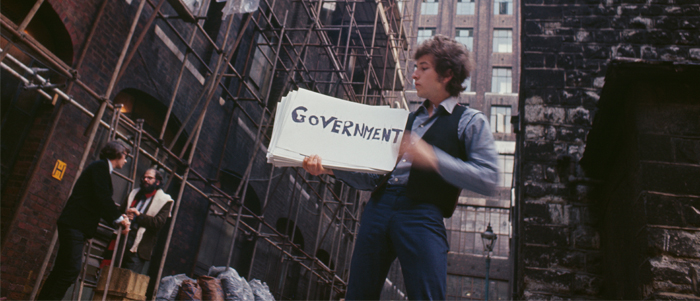Can we talk a little louder, guys?" associate professor of history Amy Dru Stanley urges her students in the course The 1960s: Politics, Counter Culture, and Social Protest. "I feel like I'm going deaf."
The miniblinds rattling in the wind are not helping. Social Science 401 has no air conditioning, just casement windows propped open by stays. The air this July morning is oppressively hot and humid; a thunderstorm seems inevitable.
The class is small but diverse. There's a high-school student from Texas and one from Korea; a Chilean student who begins studies at Chicago Booth in the fall; and two kinds of seniors: rising fourth-years and those who will graduate this summer. All of them were born after 1975, when the Vietnam War ended.
The discussion begins with the course's first fictional text, Tim O'Brien's The Things They Carried (1990), a collection of stories about Vietnam. "Historians would use this warily," Stanley says. "It's so evocative, but it's ex post facto." The students dissect the title story. Its protagonist, Lieutenant Jimmy Cross, blames himself for the death of soldier Ted Lavender.
"Most wars are about gaining territory," Stanley says. "What is so unprecedented here? How is victory being counted?"
Elizabeth, a rising fourth-year, says softly, "Kill ratio." On the board, Stanley writes "kill ratio"—the number of Vietcong killed compared to US soldiers killed. Then she writes "$400,000"—the cost, in 1960s dollars, of killing one Vietcong soldier. She says, "An incredibly chilling thing."
She turns to face the class. "Any of you boys—you or you or you," Stanley says, pointing to the male students one by one, "could have been Lavender. Or Lieutenant Cross. Did any of you think, that could be I?" The men seem taken aback by the question. Finally Sanders, a third-year history major, says no. The others remain silent.
Next on the day's reading list is an excerpt from Lyndon Johnson's 1965 speech defending US involvement in Vietnam. Stanley points to the word "promise," which occurs again and again: "We are there because we have a promise to keep." Emil, a fourth-year soon to graduate, is struck by Johnson's emotive language. He reads aloud: "To abandon this small and brave nation to its enemies … would be an unforgivable wrong."
Stanley turns to Michelle, the Korean high-school student, to ask how the Vietnam War is taught in her country. "I go to an international school," says Michelle. "The curriculum is the same as an American school."
"An international school curriculum is the same as an American school?" Sanders asks, incredulous. Michelle nods: "I'm not sure how much the Vietnam War is taught in public schools," she says. "I wish I knew more about the Korean War." The younger generation, Michelle adds, doesn't talk much about it.
At the end of the discussion, Stanley asks Elizabeth to turn off the lights. A giant screen lowers from the ceiling. A young Muhammad Ali appears on YouTube, delivering his famous statement against the Vietnam draft: "They [the Vietcong] never called me n—r."
The wind has picked up outside. Just as Elizabeth stands to close a window, it slams shut. In the next YouTube clip, Martin Luther King Jr. explains in his booming preacher's cadence why he opposes "this tragic war." Outside, the trees blow violently but without sound.
The class takes a ten-minute break. Then it's on to the 1968 protests at Columbia University, where angry students held sit-ins at campus buildings. Philippe, the Chilean student, has prepared a few discussion questions, a required part of each student's participation grade. The authors of Columbia Liberated, the statement of the Columbia Strike Coordinating Committee, claimed to be fighting for their freedom, Philippe says, "but for me they were already free. Why did they feel like they were not free?"
The students struggle to answer. "I would agree that they're already free," says Elizabeth, but they were upset about "the psychological distance between themselves and their parents or the government. They felt that they just weren't a part of the system."
"But at the same time they were," says Sanders. "A big part."
"I have a difficult time seeing what they're complaining about," says Imani, the Texas high-school student.
Stanley stops to clarify the geography of Manhattan: "Harlem sits right on top of Columbia," she says. Tensions flared when the university proposed building a new gym in Morningside Park that "would displace a primarily black population," while only part of the gym would be open to the community. "It's about who has access to urban space," says Stanley. "Who controls it?"
"What was the phrase," Philippe says. "'It's the issue, but it's not the issue.'"
"Mark Rudd," adds Emil, naming the student leader who supplied that famous justification for the Columbia protests.
"Does this strike a chord?" Stanley asks. "You could be the authors of this—these were kids your age. As you read this, do you feel detached and distanced?"
"It strikes a chord with me," says Imani. When there were bullying problems at her high school, she says, "We wrote a letter to the principal. I could see myself writing a letter like this."
At UChicago, says Emil, a student was arrested in 2010 after being loud in the Reg and, police say, not showing identification. Students gave a different account, sparking protests, "but I never went," he says. "I go to the library every day. It should have struck a chord with me, but it didn't propel me into action."
Stanley pulls up YouTube again: first Jimi Hendrix, then Jefferson Airplane performing at Woodstock. As Grace Slick wails, "Don't you want somebody to love?" an ad pops up at the bottom of the screen. "Single and Over 40," it reads. "Try Mature Singles Only."
Stanley passes out the lyrics to "Subterranean Homesick Blues." Then the students watch a film clip, a forerunner to modern music videos: Bob Dylan, in black and white, flipping through pages of hand-lettered words from the song. "What's the key lyric here?"
"'You don't need a weatherman to know which way the wind blows,'" says Sanders.
The students puzzle through the lyrics. "It warns you how to deal with the government," says Emil. "Walk on your tiptoes / Don't try 'No-Doz' / Better stay away from those / That carry around a fire hose."
"There's a strong note of paranoia about it," says Charles, a fourth-year political-science major.
"I see it's a critique," says Sanders. "It just isn't advocating anything." Philippe nods, pointing at Sanders in silent agreement.






 Video
Video



